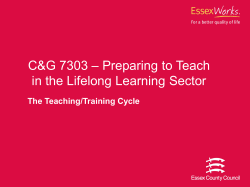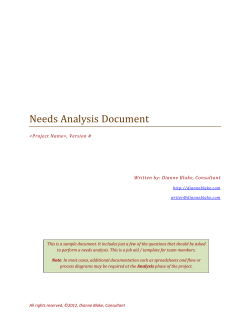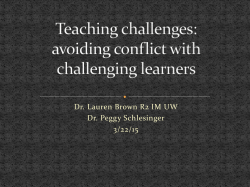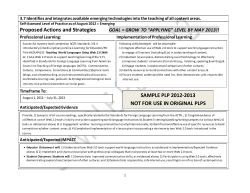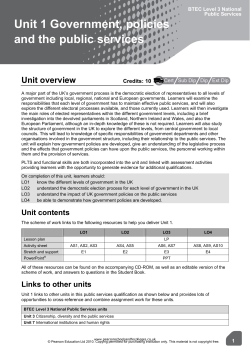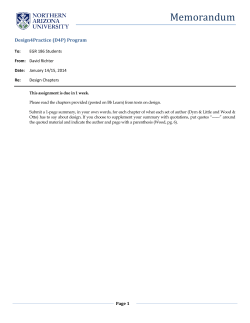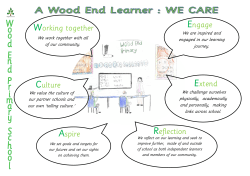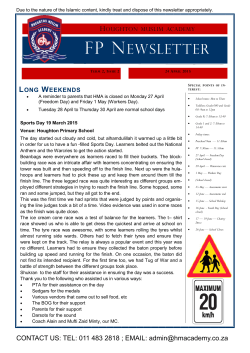
JALT Journal - JALT Publications
JALT Publications • Online Journals JALT Journal jalt journal The research journal of the Japan Association for Language Teaching JALT Journal is the research journal of the Japan Association for Language Teaching (JALT). It is published semiannually, in May and November. As a nonprofit organization dedicated to promoting excellence in language learning, teaching, and research, JALT has a rich tradition of publishing relevant material in its many publications. Volume 36 • No. 1 • May 2014 全国語学教育学会 Japan Association for Language Teaching ¥950 ISSN 0287-2420 Links • • • • JALT Publications: http://jalt-publications.org JALT Journal: http://jalt-publications.org/jj The Language Teacher: http://jalt-publications.org/tlt Conference Proceedings: http://jalt-publications.org/proceedings • JALT National: http://jalt.org • Membership: http://jalt.org/main/membership Provided for non-commercial research and education. Not for reproduction, distribution, or commercial use. THE JAPAN ASSOCIATION FOR LANGUAGE TEACHING 全 国 語 学 教 育 学 会 Reviews International Education Policy in Japan in an Age of Globalisation and Risk. Robert W. Aspinall. Leiden, The Netherlands: Global Oriental, 2013. xiv + 207 pp. Reviewed by Annette Bradford Meiji University International Education Policy in Japan in an Age of Globalisation and Risk explores a question that surely resonates with many JALT Journal readers: Why, despite much policy attention and many educational reforms, does English language teaching in Japan fail to equip students with the skills to interact successfully with people from other nations? This thought-provoking study focuses on foreign language education and study abroad programmes and the research is complemented by many examples from the author’s decades of experience in Japan. It will be of interest to anyone who has ever wondered about the level of foreign language ability among the Japanese, and many of Robert Aspinall’s arguments will ring true to those who teach English in Japan. In this informative volume, Aspinall analyses the learning of English as a foreign language through the lens of globalisation and Beck’s (1992) sociological paradigm of risk society to make sense of the decisions made by institutions and individuals that influence the outcomes of government policy. Following the Introduction, which defines international education policy in Japan and describes the limitations of conducting research on Japanese politics and society, Chapter 1 sets out the theoretical framework of the book. Then, six chapters cover the historical development of Japan’s foreign language education policies, the roles of teachers and learners in the implementation of English language education policy, the role of the private sector in language teaching, and policy and practice in study abroad. Aspinall’s picture of the English language education system in Japan is not optimistic. He describes obstacles that hinder the successful implementaJALT Journal, Vol. 37, No. 1, May 2015 59 60 JALT Journal, 37.1 • May 2015 tion of government policies that are aimed at improving language abilities and increasing student exchange and concludes that the current system “spreads misery and failure equally throughout the land” (p. 187). These obstacles comprise an overemphasis on translation in foreign language learning, the persistence of the belief that Japan is a homogenous society and the insider vs. outsider dichotomy that this belief promotes, and the disconnect between national policy and classroom practice. In Chapter 2, Aspinall traces Japan’s emphasis on the grammar-translation method of foreign language instruction back to patterns of behaviour institutionalised soon after Japan’s opening to the outside world in the 1850s; in Chapter 3 he explains how inertia in the national policymaking system, along with a fear of disrupting the system, has enabled this method to endure. Chapters 4 and 5 focus on the obstacles within Japanese schools and universities that inhibit the adoption of communicative styles of teaching and learning, including the many nonteaching duties of teachers, the intense pressure to teach to and study for high school and university entrance exams, and the compulsory, egalitarian nature of many English classes. In Chapter 6, Aspinall investigates the considerable role that the private sector has in Japan’s English language teaching industry. He explains that private and international schools, the eikaiwa industry, and English language testing companies have not bridged the gaps in communicative English fluency left by the public sector in a way that a globalisation economist might expect. Instead, many actors in this sector have complex goals, which may not actually include helping their customers attain fluency in English. In Chapter 7, Aspinall employs the risk society paradigm to highlight both the risks and opportunities involved in engaging with study abroad. Drawing upon his own analysis and previous studies, he argues that inadequate English language education and institutional loyalty and conservatism within universities and companies, along with the stress of dealing with foreign countries and people, create an incentive deficit that discourages both the outbound and inbound movement of Japanese and foreign students. Given the Japanese government’s current push towards increasing the international competiveness of its students and its focus on creating worldclass universities, a book on international education policy in Japan is both timely and welcome. A thorough evaluation of Japan’s international education policy would complement earlier works such as Willis and Rappleye’s (2011) edited volume Reimagining Japanese Education and articles and book chapters by authors such as Akira Arimoto (2010) and Akiyoshi Yonezawa (2011). International Education Policy in Japan contains a great deal Reviews 61 of useful information pertaining to the many issues surrounding English education in Japan and it piques the interest of researchers who may want to delve deeper by reading the research studies that Aspinall cites. However, the book fails to live up to the promise of its title. Despite its overall merit, the volume seems to struggle with identity. In contrast to its title, most of the book firmly focuses on English language education policy. At the beginning of the book, Aspinall states that one of his purposes is to “analyse the reasons why Japan’s international education policy at all levels has failed to equip all but a few Japanese people with the skills necessary to interact with the outside world” (p. 5), something he addresses through his focus on English language education policy rather than via an examination of the larger international education policy effort. Later, the subject of the book is presented as an examination of a “mismatch between the stages of development of the Japanese state apparatus and the population it tries to govern” as it relates to international education (p. 24), a topic much broader than the one actually addressed by this volume. Chapter 7 begins to look into the larger picture of international education, but muddles internationalisation policy and study abroad, both important topics that would benefit from in-depth treatment in separate chapters. Another point of frustration concerns the many typographical and grammatical errors found throughout the book. Generally, these are merely distractions, but at times they cause confusion. For example, the typographical error in the subtitle “Chamges in Education Policy Since 1993 in Japan” on p. 29 is distracting, and the use of duel instead of dual along with the qualifier main in the sentence that begins “Their main duel role . . .” on p. 152 requires the reader to take a second look. Even with these limitations, this book is an enjoyable read, provides a valuable foundation for those seeking to understand more about English language education policy in Japan, and is a useful addition to the growing literature focusing on Japan’s attempts to promote the international outlook of its education system. References Arimoto, A. (2010). Japan’s internationalization of higher education. In D. W. Chapman, W. K. Cummings, & G. A. Postiglione (Eds.), Crossing borders in East Asian higher education: A response to the pressures of globalization (pp. 195-210). Hong Kong: Comparative Education Research Centre, The University of Hong Kong. Beck, U. (1992). Risk society: Towards a new modernity. London: Sage. 62 JALT Journal, 37.1 • May 2015 Willis, D. B., & Rappleye, J. (Eds.). (2011). Reimagining Japanese education. Oxford: Symposium Books. Yonezawa, A. (2011). The internationalization of Japanese higher education: Policy debates and realities. In S. Marginson, S. Kaur, & E. Sawir (Eds.), Higher education in the Asia-Pacific: Strategic responses to globalization (pp. 329-342). Dordrecht, The Netherlands: Springer. Collaborative Writing in L2 Classrooms. Neomy Storch. Bristol, UK: Multilingual Matters, 2013. ix + 202 pp. Reviewed by Brett Cumming Aichi Prefectural University This new publication will be undoubtedly welcomed by practitioners as an authoritative book in the field of L2 writing, especially for those interested in practical methods of incorporating collaborative writing in class. Researchers too may benefit from the identification of questions for further exploration in an area that is still, by and large, underexplored and in which, according to the author, only a small number of published studies have appeared to date. Considered a pioneer in this field, Storch is indeed well qualified in the area of collaborative writing, which she defined as “the joint production of a text by two or more writers” (Storch, 2011, p. 275). She has published widely on issues in L2 writing, specifically peer interaction, feedback, and ESL pedagogy in general, as well as the development and the use of L1 in L2 learning. Her experience in second language learning is firsthand, having been born in Poland and subsequently raised in Israel, later graduating from Monash University in economics and sociology. Collaborative Writing in L2 Classrooms includes rationale that is theoretical, pedagogical, and empirical in nature, in addition to practical activities and methodological guidance. Storch covers theories of language acquisition and learning and also suggests tasks and addresses the practicalities of appropriate composition and sizes of groups, learners’ perspectives such as beliefs and attitudes, and computer-mediated collaborative writing. Moreover, existing literature in the field of L2 writing is critically evaluated, as are factors such as task type, L2 proficiency, and the relationships that influence Reviews 63 language learning. With an easily reviewable author and subject index, this comprehensive publication provides a thorough overview of precisely what collaborative writing is. The eight chapters are easily navigated, moving from the aforementioned rationales and theories of language acquisition and learning in Chapter 2 to a discussion of providing feedback and scaffolding in Chapter 3—a concern for many teachers of writing courses or writing techniques. Chapter 4 introduces the concept of languaging, which, according to Swain (2006), is a “means to mediate cognition” (p. 96) and “a process of making meaning and shaping knowledge and experience through language” (p. 98). A comparison between individual and collaborative texts is provided in Chapter 5, learners’ perspectives are addressed in Chapter 6, and computer-mediated collaborative writing is covered in Chapter 7, where Storch introduces opportunities for teachers and students to utilise the Internet and ubiquitous web applications such as email, chat rooms, and discussion boards. Storch skilfully summarizes the crux of collaborative writing, in which the underlying premise is that collaborative writing, when effectively used in class, results in social interaction facilitating crucial dialogue between writers. This concept has been described by social interaction theorist Vygotsky (1934/1986) as internalisation required to assist the learner in moving from complex to conceptual thinking. The author explains in a straightforward manner that in collaborative writing, learners language about language, meaning that they “deliberate about how to best express their intended meaning” (Storch, 2011, p. 276), in contrast to writing individually. Ultimately, writing collaboratively brings about the added benefit of vocalising thoughts into what the author terms artefacts, as well as other advantages, such as greater grammatical accuracy and increased motivation (Storch, 2005). In advocating strongly for collaborative writing, Storch highlights the increased opportunities for “authentic communication among learners, encouraging learners to deliberate about language while engaged in meaningful text production” (Storch, 2005, p. 171). Such a claim is supported through theoretical and pedagogical rationale as well as empirical evidence with the hope that her suggestions will prompt more teachers “to make informed decisions about how best to implement such activities in their teaching context” (Storch, 2005, p. 172). The genesis for Storch’s book was her initial collection of data for her PhD dissertation, where learning was observed in students’ interactions in pair work on a short composition task. These beginnings have culminated in this illuminative and succinct work that sheds light not only on whether col- 64 JALT Journal, 37.1 • May 2015 laborative writing provides learners with an awareness of the composition of L2 texts, but also on whether it provides students with “opportunities to learn and consolidate knowledge about L2 grammatical structures and vocabulary” (p. vii). Although not new as a research area, in that collaborative writing has been incorporated in U.S. educational institutes in pedagogy and compositional research for some decades now, readers will surely welcome the many guidelines provided. This resource will also provide reassurance to readers with reservations or concerns with respect to the linguistic skills students need to write collaboratively. It also covers how best to implement collaborative writing activities not only in a face-to-face context but also online. This book will be a welcome addition not only for those with an interest in L2 writing generally, but also for practitioners who may be looking for alternative ways of promoting effective learning. Encouraging here are the findings that when collaborative writing is conducted with guidance, students are the benefactors of a heightened awareness of better writing protocols that are not always obvious to them when writing is undertaken solitarily. References Storch, N. (2005). Collaborative writing: Product, process, and students’ reflections. Journal of Second Language Writing, 14, 153-173. http://dx.doi.org/10.1016/j.jslw.2005.05.002 Storch, N. (2011). Collaborative writing in L2 contexts: Processes, outcomes, and future directions. Annual Review of Applied Linguistics, 31, 275-288. Swain, M. (2006). Languaging, agency and collaboration in advanced second language proficiency. In H. Byrnes (Ed.), Advanced language learning: The contribution of Halliday and Vygotsky (pp. 95-108). London: Continuum. Retrieved from http://www.lrc.cornell.edu/events/past/2011-2012/papers11/swain.pdf Vygotsky, L. S. (1986). Thought and language (Rev. ed.; A. Kozulin, Ed. and Trans.). Cambridge, MA: MIT Press. (Original work published 1934.) Reviews Learning Vocabulary in Another Language (2nd edition). Paul Nation. Cambridge: Cambridge University Press, 2013. xiv + 624 pp. 65 Reviewed by George Higginbotham Hiroshima Kokusai Gakuin University Nation’s first edition of Learning Vocabulary in Another Language (2001) has been the standard reference in the field of vocabulary acquisition for over a decade. With an unrivalled 3,745 Google Scholar citations (as of October 2014), it could even be claimed to be the most influential EFL reference book in current circulation. Such is its recognition within linguistic circles that without reading beyond the contents page one might confidently recommend any updated edition to a language teacher or vocabulary researcher who has not yet read it. For many of us, though, the question is not whether this is a useful book, but whether there is anything new that would persuade us to update our dog-eared first editions. The author himself anticipates this question in the opening section and—unsurprisingly, but convincingly—supports the second edition. Citing the huge amount of research conducted during the intervening decade, he calculates, “at least one-fifth is new material” (p. 5). However, simply agreeing with the author, even one who has made remarkable contributions to the field for over 30 years, does not seem a satisfactory way to choose a book. I will therefore look at the similarities and differences between the two editions and also comment on areas that I feel were neglected. A major point of similarity between the two editions is that the broad thrust of Nation’s arguments remains unchanged. The central idea is that a language course ought to have four strands running throughout. These strands comprise learning from comprehensible meaning-focused input, meaning-focused output, a focus on form, and fluency development. In the second edition, Nation also reiterates three main themes. The first is that word learning can be most effective if viewed from a cost–benefit perspective. This means that for many learners, studying the highest frequency words will bring the best return on effort. The second theme is that word learning is a cumulative process. The 18 aspects of word knowledge that Nation specifies (p. 49) require that words must be repeatedly reviewed in a variety of ways for learners to achieve full understanding. The third theme 66 JALT Journal, 37.1 • May 2015 is that teachers ought to consider the psychological conditions conducive to word learning when designing activities. Although the broader arguments are familiar, there have been numerous revisions, most of which are supported by research that has emerged over the last decade. To be precise, there are 132 pages of new material, with three additional chapters. Some areas have been given notable attention; one of these is the Academic Word List (AWL; Coxhead, 2000). Although mentioned in the first edition, it now deserves greater discussion, having become the standard list for students aiming to enter English-speaking universities. Another area is the distinction made between low-, mid-, and high-frequency vocabulary and specialized terms. Previously, the discussion did not include mid-frequency vocabulary. These words, ranked between 2,001 and 10,000 in frequency of occurrence, represent an important band for learners and provide an additional 9% on top of the 90% coverage provided by the top 2,000 high frequency words (p. 23). The final area of note is the rewritten chapter on collocations (Chapter 12). With around 50 different terms in circulation (Nation prefers multiword unit), this can be a confusing area. Nation carefully explains the distinctions between these terms and guides the reader through a number of recent studies that clarify our understanding of multiword units and how L2 students and teachers ought to approach them. Besides these new and rewritten sections, a different tone can also be discerned. In the first edition, for example, Nation felt the need to vigorously defend graded readers: “Some writers and teachers are uncomfortable with simplification, largely because they feel that the authenticity of the text is lost. This is a mistaken view” (Nation, 2001, p. 173). Having long since won this battle, in the second edition Nation instead devotes more pages to examining how best to use graded readers. The broad scope of the book—how vocabulary is best acquired by L2 learners and the research that supports this—means that not all of the subfields within vocabulary acquisition can be fully explored. Many readers may therefore feel that their own area of interest has received insufficient attention. I, for example, was disappointed with the section on word associations as an aspect of word knowledge (Chapter 2). Although the new edition contains a better explanation of the Word Associates Test (Chapter 13), the earlier section on associative knowledge was not updated. Consequently, the explanation of how the mental lexicon is structured, from an associative point of view, relies on work published before 1991. This is unfortunate, as the large body of research compiled since then (especially in South Wales) is unrecognised. Given that Nation’s new edition is likely to be as influential Reviews 67 as its predecessor for quite some time, work within this subfield may not now receive the attention it deserves. One finding, for example, that Nation does not discuss is that the associative structure of the lexicon is not (as is often assumed) homogeneous (Fitzpatrick, 2007). This variability between individuals has also become an issue in more recent L1 and L2 word association studies. This is not the only omission. In redressing a perceived injustice to the AWL in the first edition—while maintaining loyalty to the General Service List (GSL; West, 1953), Nation also fails to mention other useful word lists. Browne (2013) and colleagues, for example, created new versions of the GSL and AWL from a two-billion-word corpus that they claim give higher coverage than the former lists. As an advisor on both Coxhead’s and Browne’s word list projects, I feel that Nation missed a unique opportunity to compare their utility as learner resources. Vocabulary acquisition is too large for one book to comprehensively cover to a depth that will satisfy every reader. Nevertheless, the lack-ofdepth criticism only detracts slightly from the huge achievement that the author has made in covering such a large field, providing a readable and well thought-through analysis of the approaches that researchers and teachers ought to take. Furthermore, when the discussion does run thin, Nation points the interested reader to books and articles that explore each subfield further. The short bibliography at the end of each chapter, as opposed to the 30-page reference list in the original, makes the task of follow-up reading significantly easier. In answer to the initial question: Yes, the updated edition is to be recommended. Second language teachers, course designers, and textbook writers would be hard pressed to find better advice on how to deal with vocabulary. Nation’s Learning Vocabulary in Another Language is therefore set to remain the authoritative text in vocabulary acquisition for the foreseeable future. References Browne, C. (2013). The new general service list: Celebrating 60 years of vocabulary learning. The Language Teacher, 37(4), 13-16. Coxhead, A. (2000). A new academic word list. TESOL Quarterly, 34, 213-238. http://dx.doi.org/10.2307/3587951 Fitzpatrick, T. (2007). Word association patterns: Unpacking the assumptions. International Journal of Applied Linguistics, 17, 319-331. http://dx.doi.org/10.1111/j.1473-4192.2007.00172.x 68 JALT Journal, 37.1 • May 2015 Nation, I. S. P. (2001). Learning vocabulary in another language. Cambridge: Cambridge University Press. West, M. (1953). A general service list of English words. London: Longman, Green, & Co. Identity and Language Learning: Extending the Conversation (2nd edition). Bonny Norton. Bristol, UK: Multilingual Matters, 2013. x + 216 pp. Reviewed by Anna Husson Isozaki Gunma Prefectural Women’s University Bonny Norton’s Identity and Language Learning: Extending the Conversation is a republication of Identity and Language Learning: Gender, Ethnicity and Educational Change, which chronicles five new immigrants to Canada who, after completing an ESL course, volunteered to meet with Norton as part of a diary study. Norton wrote, “I sought to investigate the relationship of learners to the larger social world, without resorting to oversimplification . . . questions of gender, race, class and ethnicity were central to the analysis” (p. 60). The five (pseudonymous) participants kept journals of their English language-using adventures and misadventures, taking the position of ethnographers in recording their interactions with target-language (English) users and sharing the diary contents on paper and in discussions with Norton and the other members. The events related by Eva from Poland, Mai from Vietnam, Katarina from Poland, Martina from (then) Czechoslovakia, and Felicia from Peru make compelling reading for anyone interested in crossing cultures and adapting, as well as for those interested in language learning. This second edition (made partly to offer an e-book option) retains the core chapters of the 2000 edition without alterations but adds a comprehensive update in the Introduction, summarizing movements in the field of identity and language learning from 2000 to the present. At nearly 40 pages, the Introduction’s overview of new developments in the field, including its set of references, is likely to be essential to anyone currently involved in research on identity, learner motivation and investment, and language learning. The subsequent core chapters of the original edition are then followed Reviews 69 by a substantial new Afterword as well, written by Claire Kramsch, plenary speaker at JALT2014. In the first chapter, “Fact and Fiction in Language Learning,” Norton argues that the focus in SLA theory is often on the student to the exclusion of the environment, and classrooms are devalued in contrast to idealized notions of outside-the-classroom practice. Norton notes that depending on gender, race, class, and other variables, bias encountered in the environment profoundly affects the chance to practice language, the quality of these interactions, and the consequent feelings about the target language and, furthermore, about themselves experienced by learners. Norton introduces her concept of investment to discuss learners’ sometimes shifting determinations to learn a language, their hopes of some positive “return” in their lives (pp. 50-51), and the crucial need for learners to feel a connection between classroom work and their imagined future identities and communities (p. 9). In the second chapter, Norton discusses the diverse influences on her qualitative research methods, her intention “to develop both an ethical and empowering relationship with my participants” (p. 62), and how she developed her project to fit with this conviction. Chapter 3 is a survey of international research regarding adult immigrants, documenting difficulties and fundamental ironies facing these language learners, particularly discrimination in their new countries limiting the communication opportunities they could potentially use to improve their L2 skills. Norton focuses on immigrant women in particular and why they are held back from acquiring full fluency and literacy in English—often, the prioritizing of family needs and well-being, little sense of leeway for lesser priorities (themselves), and also cultural, economic, and psychological barriers (pp. 79-85). Concluding that only by hearing participants’ own voices can we properly explore connections between learner identities, investments, and their language learning, Norton then profiles each of the five participants in her study: their living situations, work, and feelings about English and living in Canada (pp. 85-96). The fourth chapter follows the two younger participants, Eva and Mai, in their struggles and successes at the locations of their primary challenges: Eva’s at work and Mai’s both at home, which was tense and linguistically fragmented, and at work. Chapter 5 focuses on Katarina, Martina, and Felicia, the three mothers in the group, all with professional backgrounds, who are working to regain security and belonging for themselves and their families. 70 JALT Journal, 37.1 • May 2015 In Chapter 6, “Second Language Acquisition Theory Revisited,” Norton revisits the central irony facing adult language learners: “Immigrant language learners are generally more invested in relationships with target language speakers than the reverse situation” (p. 155). Based on the data culled from the diary study, she addresses what she sees as overly simplistic mainstream SLA theories. Referring to the assumption that when living in a country where the target language is dominant, plentiful opportunities will exist to practice with target language speakers, Norton writes from the members’ experiences, “on the bus, in stores or in shopping malls” when a participant “tried to engage anglophones in social conversation in these public places, they would ‘run away’” (p. 148). Norton’s final chapter, “Claiming the Right to Speak in Classrooms and Communities,” considers potential change and empowerment for language learners. Rather than abandoning traditional classwork, Norton suggests incorporating more cultural awareness tasks (pp. 173-174) and creating “social research” projects to help learners empower themselves and “critically engage” with cultural differences (pp. 188-189). Collaborative projects such as journal keeping and sharing of excerpts supply opportunities for learners to “give voice to the complexity of their experience” (p. 185) and after all, as Norton says of her study, “each woman was an expert on her own life” (p. 184). By listening as learners share, teachers can also learn about students’ investments, concerns, and hopes, and can shape classwork to better address learners’ needs. Norton suggests addressing the gaps that learners feel in output-type skills practice to strengthen their positions outside the classroom (pp. 172-174), and notes that journal keeping and sharing provide practice “speaking up” in writing, and potentially verbally as well (p. 185). Norton mentions parallels to consciousness raising groups in the 1970s (p. 183), and her examples from the five women’s experiences of taking more assertive stances toward issues in their lives are intriguing and ultimately hopeful. In the Afterword, Claire Kramsch examines the philosophical influences on Norton’s work and the context of the book in its first edition and the present edition: globalization, IT improvements stimulating communications across borders, English as a lingua franca movements, and new awareness of the importance of social relations in language learning (pp. 192-194). A small but persistent drawback to the volume is an absence of appendices which might have usefully included some of the surveys, letters, and charts Norton describes handing out during her project, such as an adapted Likert scale questionnaire she developed (Chapter 2). The Index, also, is rather inadequate, lacking terms used in the chapters that readers might Reviews 71 wish to find again (consciousness raising is missing, as is collaboration, and educational research is listed as only from pages 58-60.) Another possible drawback for some readers is that the content is not focused specifically on EFL. That said, with global migration, travel, and social media, our learners are hardly immune to issues of power and access, and they do and will have encounters in which more is involved, and at stake, than merely words. The deeper reflection and consideration of issues affecting learners that Norton encourages is likely to be of genuine value for all teachers. Norton writes, “The goal for future research on identity and language learning is to contribute to efforts to promote language learning and teaching in ways that can enhance human agency in more equitable worlds” (p. 22). Strengthened by the thorough updates in the new Introduction and the context provided by Kramsch in the Afterword, the book makes a persuasive case for language teachers to regard our learners and their investments in a more holistic light. It may also shed some illumination on our experiences as L2 learners ourselves. Multiple Perspectives on the Self in SLA. Sarah Mercer and Marion Williams (Eds.). Bristol, UK: Multilingual Matters, 2014. xi + 188 pp. Reviewed by Garold Murray Okayama University Interest in the topic of identity, which has characterized work in the field of language education since the turn of the century, has recently focused on the self. References to the self in the literature on SLA in general, and second and foreign language learning in particular, are now commonplace. Less common are clear and cogent explanations of what writers actually mean when they refer to the self. Discussing the difficulties involved in defining the self, the renowned American cognitive psychologist Jerome Bruner once reportedly quipped that the best most of us can do when asked to describe a self is point a finger at our chest. Given this state of affairs, Sarah Mercer and Marion Williams’s edited volume, which aims to elucidate and enhance current understandings of the self, is not only timely but also makes an invaluable contribution to the field of language learning and teaching. 72 JALT Journal, 37.1 • May 2015 To accomplish their aim, the editors bring together diverse perspectives on the self in the hope that readers will be able to see how these positions might complement each other and, subsequently, make connections that will ultimately lead to the emergence of a more comprehensive view of the self. The organization of the book reflects this strategy. Early chapters that treat aspects of the self such as self-efficacy, self-confidence, and self-esteem are followed by chapters that have a wider scope, exploring broader constructs like identity and motivation. The final chapters offer perspectives that show promise as a means of moving to a more holistic view of the self. Each chapter provides a reader-friendly overview of the theoretical constructs under consideration, a review of salient research, and in most cases, a reflection on the implications for pedagogical practice, making the book a “must read” for teachers, researchers, and graduate students. Following an introduction, which serves as a reader’s guide to the book, the beginning chapters examine several closely related constructs. In the first of these, Nicole Mills (Chapter 2) brings a social cognitive perspective to bear on the topic. She discusses the importance of learners’ self-efficacy beliefs and suggests steps teachers might take to support their development. Next, Sinthujaa Sampasivam and Richard Clément (Chapter 3) address L2 confidence. Of particular interest to educators working in foreign language contexts like Japan is the authors’ argument that opportunities for L2 interactions—contact with the target language and culture—are essential if students are to develop L2 confidence and ultimately a desired L2 self. In Chapter 4, Fernando Rubio takes up self-concept and self-esteem. After clarifying conceptual aspects of these constructs, he outlines how teachers can foster learners’ self-esteem by creating a safe learning environment in which learners’ identities are honoured and support is given to their sense of belonging, purpose, and competence. Although these chapters provide insights into perceived aspects of the self, they leave the impression that the self is a somewhat fragmented “family of phenomena” (Sampasivam & Clément, Chapter 3, p. 36). Subsequent chapters take a broader view of the self. For example, Bonny Norton (Chapter 5) discusses insights poststructuralist theory has brought to understandings of the role of identity in language learning. She urges teachers to recognize learners’ multiple identities and employ pedagogical practices that encourage them to engage or invest in language activities. Informed by postmodern, sociocultural, and poststructuralist perspectives, Chantal Hemmi (Chapter 6) reports on case studies of bilingual Japanese women that suggest they experience a different sense of self depending on Reviews 73 which language they use. Continuing to explore the theme of the contingent and shifting self, Florentina Taylor (Chapter 7) introduces the notion of public selves versus the private self. In the ensuing discussion, Taylor cautions teachers that what learners think about themselves as language learners may not be reflected in their behaviour in the classroom due to such factors as peer pressure. This is followed by Stephen Ryan and Kay Irie’s (Chapter 8) exploration of the role of imagination and narrative in the formulation and ongoing evolution of the self as well as the L2 self. Drawing primarily on the L2 motivational self-system and self-determination theory, Ema Ushioda (Chapter 9) focuses on how language-learning motivation becomes a part of the self and the role the social context plays in these processes. Overall, these chapters suggest that teachers can support learners’ developmental processes by establishing safe learning environments that honour learners’ identities and promote mutual engagement, self-regulation, and learner autonomy. The final chapters come closer to tackling the crucial, but daunting, question: What is the self? Georg Northoff (Chapter 10) addresses this question by demonstrating how combining phenomenological theory with advances in neuroscience can enhance our understanding of the self. This is followed by Mercer’s examination in Chapter 11 of the self as a complex, dynamic system that encompasses the various self-constructs, identities, and beliefs. A strength of Mercer’s perspective is that it provides researchers and theorists with the means to explore aspects of the self while not losing sight of the whole. To conclude the book, Mercer and Williams (Chapter 12) consider the contributions the various chapters make to theory, pedagogical practice, and research. They also identify challenges that lie ahead in the ongoing quest to understand the self. According to Mercer and Williams, the next challenge facing scholars is to determine how current theoretical perspectives and constructs might fit together to form a holistic conceptualization of the self. By bringing together different perspectives, which makes it possible to note points of convergence, this book represents an important step in this direction. Another key challenge identified by Mercer and Williams is the need to investigate the relationship between the self and language pedagogy. A theme running throughout the book is that, for language pedagogy to be effective, learners have to be able to relate the learning to their sense of self. In Mercer’s words, “As teachers, our challenge is to ensure that learners can connect their language learning experiences in class with their underlying, continually emergent core sense of self in a positive way” (p. 174). Given the centrality 74 JALT Journal, 37.1 • May 2015 of the self to language learning and teaching, anyone and everyone involved in language education should read this book—at least twice. The Handbook of Spanish Second Language Acquisition. Kimberly L. Geeslin (Ed.). Chichester, UK: John Wiley & Sons, 2014. v + 553 pp. Reviewed by Cecilia Silva Tohoku University Kimberly L. Geeslin has collected an outstanding set of papers that address the following issues of Spanish language acquisition: theoretical and methodological approaches; phonology, grammar, individual and social factors; and language acquisition in the classroom. The book comprises an introduction and five parts, with a total of 30 chapters that show the recent ubiquity of high quality research conducted on Spanish second language acquisition. The Handbook of Spanish Second Language Acquisition is an excellent compilation of scholarly papers focused on research. This focus notwithstanding, teachers of Spanish as a second language will also find the studies and their applications to be quite stimulating. For example, research on the acquisition of commonly mistaken features such as the prepositions por/para (p. 33), the verbs ser/estar (p. 456), and the order of adjectives (p. 288) can furnish educators with hints for teaching. It is worth mentioning the chapter “Teaching Pronunciation in Second Language Spanish” by Gillian Lord and Maria Fionda, who consider an important issue from the perspective of the classroom: What is known so far about teaching pronunciation and what should be explored from now on? Furthermore, research on the language instructor, in “Instructor Characteristics and Classroom-Based SLA of Spanish” by Laura Gurzynski-Weiss, is meant to provide insight into the context of learning an L2 and is relevant to the theory and practice of language acquisition. The first part, “Theoretical and Methodological Approaches to the Study of Second Language Spanish,” contains six chapters. In the first, Amaya Mendikoetxea reports on the use of corpora-based SLA research related to the acquisition of specific aspects of Spanish grammar such as the copula verbs ser and estar, word order, or the null/overt realization of pronominals. Reviews 75 The other five papers report on the application of several approaches to research on Spanish language acquisition. For example, there are functional studies focusing on prepositions por and para, generative approaches used to explain differences in L1 and L2 acquisition in adulthood, psycholinguistic approaches to understanding brain mechanisms involved in language processing, observations from the perspective of variationism accounting for the complex nuances of interlanguage and the developmental process of language acquisition, and cognitive linguistic approaches that show the connection between language and human cognition in areas like figure/ground segregation, metaphors, and metonymy. The second part, “Phonology in Second Language Spanish,” contains four chapters, beginning with Mary Zampini’s “Voice Onset Time (VOT) in Second Language Spanish,” which offers a complete overview of VOT research on the production of Spanish stop consonants and perceptions by nonnative speakers of Spanish. Then, in “Speech Perception in Second Language Spanish,” Polina Vasiliev and Paola Escudero shed light on difficulties that adult learners from different L1 backgrounds have with the perception of segments (vowels and consonants) and suprasegmental features (stress and intonation). These authors raise two important issues: Spanish intonation is particularly challenging due to the great deal of dialectal variation and the perception of L2 Spanish segments has been less researched than their production. Subsequently, Manuel Díaz-Campos outlines the phonetic inventories of Spanish and English, offers a description of shared elements, and also refers to the factors considered to account for L2 phonological attainment, such as maturation, perception, motivation, and identity. This part concludes with Nicholas Henriksen’s chapter “Suprasegmental Phenomena in Second Language Spanish,” which focuses on suprasegmental structures in Spanish including prosody, stress, intonation, rhythm, and speech rate. The nine chapters in the third part, “Developing Grammars in Second Language Spanish,” provide insightful contributions to several areas of Spanish grammar. The chapter about direct and indirect object pronouns (clitics) reviews the research carried out in two categories: studies on L2 production and studies on grammatical processing according to specific approaches such as cognitive-functionalism, linguistic theory, the interface hypothesis, and the model of input processing. Chapter 15 highlights the L2 acquisition of subject pronouns from the perspectives of generative approaches, processing theory, discourse pragmatics, and a sociolinguistics-variationist model. There are four chapters regarding verbs in this part of the Handbook. In addition to outlining the results of off-line and online studies on L2 ac- 76 JALT Journal, 37.1 • May 2015 quisition, in Chapter 12 on grammatical gender, Irma Alarcón analyzes thoroughly the functions of copula verbs ser and estar (both equivalent to the English verb to be). Chapter 14 provides an overview of the acquisition of L2 Spanish tense and aspects from the perspective of several approaches, focusing on the contrast between perfective and imperfective past morphology, and offers a brief explanation of the application of research for teaching the preterite–imperfect contrast. Llorenç Comajoan Colomé cites the example mentioned by Pérez Saldanya (2004) and Lunn (1985) to clearly distinguish between the preterite, perfective aspect (bailé: I danced, when the situation is viewed as a whole) and imperfect, imperfective aspect (bailaba: I danced/ was dancing, which points to one phase of the situation). Chapter 16 covers an analysis of linguistic and developmental factors that influence the acquisition of the subjunctive by English speakers. Chapter 17, about word order, offers a wide range of research methods and a general overview of Spanish interlanguage on this topic. In the chapter about meaning, Roumyana Slabakova examines how learners come to understand and convey meaning, and presents several theoretical approaches. The last chapter of the third part, “Language in Context,” refers to pragmatics and describes interdisciplinary theoretical frameworks used to focus on language users and the contexts in which they interact. The five chapters of the fourth part, “Individual and Social Factors in Second Language Spanish,” describe the current positions and thoughts related to personal and social aspects that may influence language acquisition in general and Spanish language acquisition in particular. In this part, there are at least two highlights. One of them is the definition provided by Silvina Montrul of “ultimate attainment” as “the final state and stable grammar of people who have completed the language acquisition process” (p. 353). This author discusses the possibilities of acquiring a native-level potential in Spanish, focuses on age effects, and points to the notion that, according to research, learners who begin acquiring an L2 after puberty are unlikely to reach a native speaker level of proficiency. The other point, developed by Barbara Lafford and Izabela Uscinski (p. 386), is that research has found that study abroad does not meet all expectations in terms of delivering high levels of linguistic and cultural competence, thus the need for expanded research using more socially based frameworks centering on interaction. The fifth part, “Acquisition in the Second Language Spanish Classroom,” refers to input and output of the skills and other components of an L2: grammar, reading, writing, vocabulary, and pronunciation. The author of the last chapter, Gurzynski-Weiss (p. 530), suggests that in many cases the instruc- Reviews 77 tor is the only link between the learners and the L2; thus, she advocates research on the instructor’s characteristics, in particular his or her training and background. The Handbook of Spanish Second Language Acquisition offers a comprehensive and critical overview of research on phonology, grammar, and methodology. However, a criticism would be that culture-related issues such as intercultural sensitivity and intercultural competence are just briefly mentioned in Chapter 22, which focuses on the benefits and the effect of contextual, individual, and social factors related to immersion via study abroad on Spanish acquisition. It should be mentioned that each chapter contains a thorough analysis of the topic, a suggestion of areas that deserve further investigation, and a list of extensive references. In addition, the most effective aspects of the book are the choice of very specific features in Spanish acquisition and the depth of the research. Compared to other quite extensive investigations—for example, Macaro (2003), whose research on writing covers a good number of aspects of language acquisition—Chapter 27 “Acquisition of Writing in Second Language Spanish” by Marly Nas and Kess van Esch develops three specific issues: writing process, writing product, and the role of feedback. Unlike the 11 papers gathered by Salaberry and Lafford (2007), which focus on how practice and teaching are enhanced by research, The Handbook of Spanish Second Language Acquisition is centered on a critical review and assessment of research into acquisition of Spanish, identifies areas that are in need of further study, and provides readers with theoretical data as a basis for teaching. Thus, this title from the Wiley series of handbooks constitutes an indispensable and highly recommended resource for researchers conducting investigations and also for educators in practice. References Lunn, P. (1985). The aspectual lens. Hispanic Linguistics, 2, 49-61. Macaro, E. (2003). Teaching and learning a second language: A guide to recent research and its applications. New York: Continuum. Pérez Saldanya, M. (2004). Los tiempos verbales: Dificultades teóricas y terminológicas. [The verb tenses: Difficulties in theory and terminology]. In L. García Fernández & B. Camus Bergareche (Eds.), El pretérito imperfecto (pp. 194-228). Madrid: Gredos. Salaberry, R., & Lafford, B. (2007). The art of teaching Spanish: Second language acquisition from research to praxis. Washington, DC: Georgetown University Press. 78 JALT Journal, 37.1 • May 2015 Quality Assurance in Distance Education and E-learning: Challenges and Solutions From Asia. Insung Jung, Tat Meng Wong, and Tian Belawati (Eds.). New Delhi, India: Sage, 2013. xxiv + 307 pp. Reviewed by Shawn R. White Konan University Quality Assurance in Distance Education and E-learning: Challenges and Solutions From Asia serves as a good overview on the state of content development and provides information on regulation and oversight in quality assurance (QA) in higher education around Asia. Although this is a book focused on distance education (DE), the information applies to all higher education institutions because the regulation of DE falls under the same oversight as brick and mortar schools. Additionally, with the growing use of technology in the face-to-face classroom, differences between DE and traditional learning are beginning to blur with integration seeming inevitable. Because the book provides persuasive examples of effective organizing principles applied and evaluated in a number of Asian countries, it is a valuable read for anyone interested in e-learning. The book is divided into five parts that cover systems theory, management, pedagogy, learner support, and measuring outcomes. Individual chapters address the theme of each part within the context of a particular institution or educational provider. The organization is easy to follow and allows for a broad overview of a variety of issues faced in different cultural environments. The sum of the papers presents strong evidence for a balanced systems approach, drawing from hard and soft systems theory to address “the need for both types of approach, and for greater awareness of their respective qualities” (Naughton, 1984/2012). Such a balanced approach also includes all levels of staff in the development of not only DE but of curriculum in any higher education program. Whether it is worth wading through the many detailed descriptions of government oversight programs (which could have been summarized or simply referenced) will depend on the goals of the reader and his or her familiarity with the context. Nevertheless, there are definitely some gems to be found. In Part 1, “A Systems or Balanced Approach to Quality Assurance,” the four chapters are based on contexts in Singapore, Thailand, Hong Kong, and Reviews 79 South Korea. The authors provide a good feel for how each country has set up their DE program and what kinds of systems are in place to insure continued QA. However, because there is no introduction or discussion at the end of this section (or any of the five parts), a reader must infer why the papers are considered examples of a balanced approach. From my perspective, as a user of open source online Learning Management Systems (LMS), the paper by Cheong Hee Kiat on the Singapore Institute of Management left me wondering about the evaluation criteria for the university’s proprietary LMS when compared with the open source LMSs of the five universities it claims to be benchmarking against. In Chapter 3 on Hong Kong’s Open University, Robert Butcher presents an excellent study of involving adjunct teaching staff in course development, something I have long advocated. In addition to providing a reference in support of collaborative course development, the author offers a clear rationale for where DE online content is most effective compared to face-to-face courses. Part 2, “Ensuring the Quality of Management Processes,” provides an overview of the regulatory environments in Indonesia, China, Mongolia, and South Korea. Details are provided on various government regulatory systems, implementation, auditing, stakeholders, oversight, and review. This content applies not only to DE, because the oversight regulatory systems discussed are relevant to all higher education, including language learning programs. From each of the four chapters in this part, one can get the feel for the culture of both the institution and the country. This could provide valuable information to anyone wanting to work in that country, for example, how top-down bureaucratic a nation is, and the status of associate and tenured professors. Again, because there are no discussions or synthesis of the chapters in Part 2, it is left up to the reader to read between the lines, count how many agencies and procedures are in place, and imagine what it would be like to work, develop content, or publish in these nations. Part 3 is titled “Focusing on Instructional Design and Pedagogy.” In Chapter 9, by Katsuaki Suzuki, it was refreshing to read a report that is honest about the condition of QA in Japanese universities being “piecemeal, generally consisting of occasional seminars . . . . [and] student evaluation of completed courses, which may not lead to substantial improvement in the quality of teaching and learning” (p. 146). It was more encouraging however to read how Kumamoto University has addressed this issue by institutionalizing a Course Team approach to “check course quality while the materials are under development” (Kitamura et al., 2007, as cited by Suzuki, p. 146). The chapter outlines how this fresh approach avoids creating a course designed 80 JALT Journal, 37.1 • May 2015 by a single sage, working instead to collaborate to successfully meet new national standards set by the Japanese Ministry of Education, Culture, Sports, Science and Technology (MEXT). Suzuki presents further informative detail on how this small university is successfully developing this approach in Japan. It is interesting to note that the scope of the program is strictly limited by the government to a very small number of degree students, “15 per year for a master’s program and three per year for a doctorate program” (p. 142). Those with background knowledge of the context and awareness of how very strict Japanese universities are on attendance can understand that a DE program with no classroom attendance required could be viewed skeptically and therefore a large program might not be easily approved. However, I was unable to draw as much from the other papers of Part 3 in the same manner. Because most readers are similarly not likely to be aware of the breadth of contexts covered, which include China, India, and the Philippines, some discussion specific to each part of the book would have been a useful addition. Even a section of questions to be considered would have served to unify and clarify the intent of the book editors in their selection of these papers. In the two chapters in Part 4, “Assuring Quality of Learning Support and Assessment,” evidence from Malaysia and Pakistan does indicate clearly that quality in the areas of learning support and assessment is dependent on the involvement of all staff at all levels. This also supports the concluding remarks in the book by Jung that a balanced approach that includes the flexibility to adapt and change to meet new goals as they arise is critical to a successful program. This is reflected in particular in the case of Pakistan (Chapter 14), where Naveed Malik states that there is an “absence of established standards” and that the collaborative approach was helping to “formulate and establish these standards” (p. 224). Part 5, “Outcomes and Performance Measurement,” comprises two chapters. In Chapter 15, Uma Coomarawamy from Sri Lanka mentions extensive reviews by committees internal and external, but details on the how to attain quality were unclear. There is mention of the use of the Course Team concept, in-house training, and home-grown bottom-up ownership, but little detail is included on who made up a team and how this was executed. Performance Indicators (PI) are said to have been developed and reviewed by an international team but again, more detail on the development process of the PIs would provide useful information for readers looking to replicate their approach and emulate their success. Furthermore, much of the QA seems to depend on external review from conventional universities, which Reviews 81 draws attention to the notion of expertise available in the scope of DE and e-learning as mentioned in the book title. Chapter 16, set at the Open University Malaysia, was thorough in listing the outcomes achieved and gave much more detail as to what the QA measures were and examples of the implementation. This bolsters the statements made in the concluding remarks that close out this part, stating that to be an effective flexible education provider means developing a quality culture and innovative environment. Did I find information on the things I was looking for? Briefly, yes. First, did I find information about what regulatory and oversight systems are in place to support development? Yes, clearly. Although some institutions have been more forthcoming than others, there is enough provided here to make a very strong argument in support of greater collaboration and an involvement of all levels within institutions facing modern educational challenges. Second, were there details on how content and systems were set up to provide a quality experience for the learner? In a larger sense, yes, many of the authors provided insight into how to get people involved from the start. Although not all of the authors addressed this fully, it was quite quickly apparent when an author was not volunteering such detail, and I could jump ahead. I can firmly recommend this book for anyone looking for insight into breaking the mold of industrial educational practices to establish enduring QA innovation. I can also recommend this book for anyone looking to find information on the political and cultural environments in various Asian nations that may influence decisions or the uptake of the educational innovations available through blended learning, flipping the classroom, or content delivered through new technology such as m-learning. References Kitamura, K., Suzuki, K., Nakano, H., Usagawa, T., Ohmori, F., Iriguchi, N., … Migita, M. (2007). Quality assurance efforts at an online graduate school to train e-learning professionals: A case of instructional systems programme at Kumamoto University. Journal of Multimedia Aided Education Research, 3(2), 25-35. Naughton, J. (2012). Soft systems analysis: An introductory guide. Athabasca, Canada: Athabasca University. (Original work published 1984.)
© Copyright 2025
